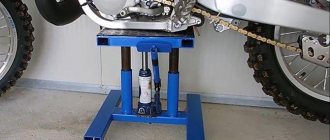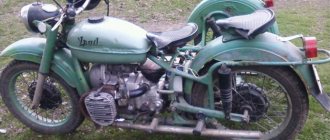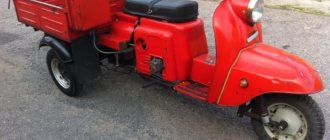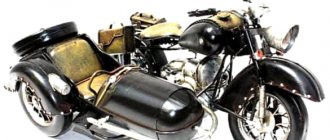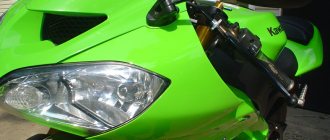Author: Evgeny Zhivoglyadov. Date of publication: September 13, 2022. Category: Motor vehicles.
Motorcycle bags are made from various materials: metal, plastic, leather or plywood. The choice depends on personal preferences and skills. If you decide to make motorcycle panniers with your own hands, you can be sure of their exclusivity. And if you approach their decoration with due diligence and imagination, then they will become not only convenient luggage racks for transporting various items, but also a unique decoration of the bike.
Motorcycle panniers – fashion or necessity
More and more people today choose a motorcycle to get around.
This type of transport can drive on any roads and bypass any traffic jams. But there is a problem and a very significant one. The motorcycle is not designed to carry luggage. And when planning a long trip on a motorcycle, you have to take with you the necessary things that need to be put somewhere. Driving around the city, and even more so outside of it, should be convenient and comfortable. To do this, having only a bike is not enough. It will become complete if it is universal. And for this purpose, many motorcyclists install such an additional accessory as motorcycle panniers on their motorcycle.
Motorcycle trunks and bags are not a tribute to fashion, they are a necessity.
Their main purpose is to store and transport items so that the motorcyclist does not feel inconvenienced when transporting them.
Even minimal things are necessary for a person when driving. Be it documents, any necessary things and accessories. Gradually, the motorcycle acquires the necessary things for a motorcyclist. There are no additional drawers or compartments in the motorcycle. And motorcycle trunks are the ideal solution for neatly storing all these things.
In order to install panniers on a motorcycle, there are special fasteners. They are made of special and durable materials so that the motorcyclist is confident in the safety of everything carried while driving. The materials used to make the cases are waterproof so that the items in them are not damaged in any weather.
Greetings to everyone who reads this article of mine. And it doesn’t matter whether you are related to motorcycles or not. This article is about how I made my own rear center pannier. When I bought my SiBishka, I was sure that I would not only ride around the city on a motorcycle, but go to festivals and generally travel. Therefore, I immediately began to little by little prepare the motorcycle for this. Roll bars were made for it (Safety bars for my Honda CB 400SF). A little later, the shock absorbers were replaced with longer-stroke YSS ones, which were intended for the heavier CB1000 motorcycle (YSS shock absorbers operating experience). And then I made a luggage system (Trunk for my Honda CB 400SF) and homemade side cases for it (Creating side cases for the Honda CB 400 SF), although I later abandoned them due to their large size and weight. Then it was time for the center rear case. I thought for a long time about what to make it from. Many materials were no longer available due to their price or the inability to obtain them at that time. As a result, when I went to a well-known store for military and tourist equipment, I came across a fisherman’s bag. The bag, although textile, is quite rigid and roomy.
But still, what I liked the most were the panniers that are installed on the BMW R1200GS motorcycles. I liked their shape.
But I understood perfectly well that I was not yet able to buy these for myself. Even the analogues are still a little expensive for me.
But one day I found out that one of my friends works as a milling machine operator in an advertising company. In particular, he is engaged in cutting aluminum sheets and composites. And besides, he invited me to work as a welder for their company. After thinking about it a little and thinking it over, I decided that since I couldn’t buy such a case, it was worth making it myself. Well, if not exactly the same, then at least similar. Moreover, since the material has become available (read: free), there is someone to make blanks on a machine. And I sat down to draw the details of the case on my computer in CorelDRAW. A friend helped correct some inaccuracies in drawing details. After which he cut out all the parts for me on the machine. Some were made of composite and some were made of aluminum.
The assembly didn't really move very quickly. Either there was no inspiration, then I was busy at work until late, or I was frankly lazy. But still the work progressed.
Unfortunately, the parts of the case were cut from a composite of different colors. Although I only wanted black. But later I simply repainted all the composite parts black.
During the entire assembly process, my girlfriend Galka Lapkina actively helped me. She herself was interested in doing this. She held the pieces together while I riveted them. She gave good advice during the assembly process. Thanks to her advice, I ended up abandoning less-than-thought-out and unsuccessful ideas.
There was only one problem during the entire assembly of the case. A seal was needed between the case itself and the lid. I spent a long time looking around the city for a suitable U-shaped seal. But as it turned out, it is almost impossible to get it in my city. I saw a more or less suitable seal in a furniture fittings store. But it was translucent and after gluing it to the composite, all the glue showed through, which was very ugly. I had to sit for a painfully long time to cut it off with a utility knife. And then I bought the seal in Moscow. Thanks to a fellow biker from Moscow. He agreed to drive halfway across Moscow to buy it and bring it to Tver. But now the seal looks nice.
I ordered the lock for the case on a well-known Chinese website.
The bottom and lid of the case were reinforced with additional sheets of composite.
Attached to the lid is a handle made from nylon sling. At first I wanted to make a rigid handle, but then I abandoned this idea. Since the tent had to be attached to the lid of the trunk and the hard handle would have interfered with this.
Four ears are attached to the inside of the lid, through which an elastic band passes. It serves so that a sleeping bag can be secured in a free space in the lid.
For insurance and to prevent the lid from opening too wide, it is connected to the main part of the case with a chain. I really think it’s worth making such a chain on both sides of the case, and not on one.
There are mounting brackets in the lid and in the main part of the case. With their help, I attached a tent and an air mattress to the trunk.
The case itself is attached to the luggage system of the motorcycle using eight M6 bolts, several pressure plates, between which shock-absorbing rubber is laid.
Unfortunately, I was never able to come up with a quick-release system for attaching the case, so I settled on this option for now. Although there has not yet been a chance to remove the case. It is convenient to go to the grocery store with it. It’s comfortable for my girlfriend to ride with the number two pannier, she has something to rest her back on.
First, a small test was arranged for the case. A trip to the village to visit my aunt. We were taking some food to the village. And pickles and vegetables come back from the village. Then there were several trips to motorcycle festivals. The longest trip was Tver-Gomel via Vitebsk. This is approximately 900 kilometers.
The case was tested and all trips were successful. There are still some small ideas left for how to improve it. For example, there is an idea to cover the inside of the case with isolon in order to protect things from damage by rivets. My girlfriend is against it. Claims that the place will be lost. But this is still being considered.
Well, that seems to be all.
PS Please express only constructive criticism, suggestions and ask questions. And let all sorts of flooders who like to chat that is not relevant, let them immediately go sideways. First, do at least something of the same level, and then talk.
Types of motorcycle cases
According to their shape and type, trunks are divided into several varieties.
Side cases
They are modeled after the duffel bags used by cowboys.
Such bags were thrown over the horse's croup. Used them for long journeys. Side panniers for motorcycles are secured with a belt that goes over the seat of the motorcycle. They are located near the rear wheel on both sides. Large and voluminous panniers are installed on choppers, because these are the type of motorcycles that are used for long trips. Their form is constantly changing and modernizing. New models of trunks may have different carrying capacity and volume, different appearance, but their purpose is the same - to transport and store luggage, which contains things that may be useful on the road.
Rear case for motorcycle
Such trunks are made in a wide variety of types. Rectangular, in the form of loaves of small and impressive sizes. Cases are produced in the form of crosses and bags. Cases in the form of bags have, like backpacks, a large number of different pockets.
The rear case is placed behind the motorcyclist's back. If a two-wheeled vehicle has space for a passenger, then the trunk is attached to its back. If not, then use the rear fender or trunk for mounting. With the help of a rear case you can increase the volume of things that you take on the road.
Coffer loaf
This case has the shape of an elongated cylinder. It is convenient to attach it to the fork of your motorcycle. You can also do this near the engine. It's convenient to put drinks or keys there.
Side cases for motorcycles
On the Izh motorcycle, metal side glove compartments are already built in at the factory. They are located between the shock absorber and the gas tank. Such cases perform a dual role. Firstly, you can put all the necessary tools there. After all, anything can happen on the road, and you will definitely need them. Secondly, they cover the battery. All vulnerable components of the motorcycle are reliably hidden in such side bags.
DIY motorcycle trunk
Even before purchasing our Honda Silver Wing 600cc maxiscooter, my wife and I were already planning future trips. Well, what’s a long-distance bike without luggage, which is sometimes quite problematic to attach to a motorcycle? No ready-made version of side frames or cases can accommodate as much luggage as a homemade one.
First of all, we need to think carefully about where the mounting points for our trunk will be. It’s great if the motorcycle comes from the factory with a design that allows you to easily attach the rack to the frame. Sometimes it is worth resorting to studying the factory options of luggage racks that are on the market. For example, the company Givi specializes in producing such add-ons for motorcycles. That's what I did: I found photos of my motorcycle with installed side frames in a search engine, then adapted them to my trunk, modifying them a little.
After this, you can begin making the mounting ears. At the top points, my future trunk will be attached to the standard places on which the platform for the trunk is installed by the manufacturer. This makes the job much easier. The material from which the fasteners will be made is a steel strip, the thickness of which is 4 mm.
To give the fastenings the correct shape, the strip must be marked and bent in a shape that follows the platform. Having a yew and a hammer, this is not difficult to do. Here's what I got:
As you can see, I reinforced the design of the luggage racks with gussets on the sides and added transverse rods so that the bag would not sag or fall out.
Next, you can weld the trunk to the mounts themselves. It is best to do this locally in order to guess as correctly as possible with the location of the “ears” on the frame. To do this, it is necessary to protect the motorcycle as much as possible from the effects of temperature and voltage of the welding machine. I completely removed the battery and wrapped the plastic in wet rags, cardboard and old linoleum. This is what it looked like:
Let me clarify right away: on a motorcycle you just need to grab the frame at a few points; you only need to weld it when it’s removed.
To ensure that our frames do not touch the plastic of the motorcycle and are rigid and motionless, they must be secured at the lowest points. I made a jumper between them, which, in turn, is attached to the motorcycle frame:
I also welded brackets of the required length to the frames themselves, allowing me to secure the trunk at the bottom:
And, of course, I painted them. Here's what we ended up with:
And here is my trunk during long journeys:
Materials used to make cases
A variety of materials are used to make trunks. It can be plastic and metal, leather and textiles. Leather trunks for motorcycles can be made from either genuine leather or artificial leather. The color of leather trunks can be black or brown.
When searching for a leather trunk, you may see the phrase “special leather” in the product description. This means that two materials were used in production - leather and plastic.
Special leather using natural material is impregnated with a special coating. Therefore, such a case will not get wet and will not become deformed. The thickness of the skin can be three to four millimeters.
Faux leather
Faux leather is thinner. To make the frame product more durable, thick plastic is used here. If you plan to drive off-road, artificial leather would be your best option. Firstly, the price is much cheaper. Secondly, it does not allow moisture to pass through and is not exposed to any chemicals. In appearance, such leather does not differ from natural leather.
Plastic saddlebags for motorcycles
Plastic motorcycle trunks are made of monolithic plastic. This is a fairly durable and lightweight material. It is used in the production of billboards, in the automobile and aircraft industries.
Rear and side plastic trunks for motorcycles are made of plastic, the thickness of which is up to two millimeters. And the wall that is attached to the motorcycle is made of thicker plastic. Small-sized cases are not made from plastic. Plastic products are very durable. They can last up to twenty years. Side cases can be installed on any motorcycle model. The shape of the panniers follows the shape of the rear fender of the bike.
Plastic cases are represented by three companies that are well known to motorcycle enthusiasts. These are two Italian companies - Givi and Karra, and a company from Spain Shad. The volume of plastic cases varies from thirty to forty-eight liters. Load capacity - from three to ten kilograms.
In specialized stores you can always choose a trunk or bag for a motorcycle of the size and carrying capacity you need.
Publication date: September 13, 2022. Category: Motor vehicles.
Motorcycle bags are made from various materials: metal, plastic, leather or plywood. The choice depends on personal preferences and skills. If you decide to make motorcycle panniers with your own hands, you can be sure of their exclusivity. And if you approach their decoration with due diligence and imagination, then they will become not only convenient luggage racks for transporting various items, but also a unique decoration of the bike.
Cargo rack
The next type is a separate trunk for transporting goods. This design appeared in Soviet times. At that time, it was made mostly of steel rods. Let's take a look at its features and variations of making such a trunk with your own hands.
Of course, let’s move a little away from the old days, and using the example of manufacturing, we’ll look at a trunk for more modern motorcycles, since they currently dominate the world of motorcycles. Such an example would be the manufacture of a structure only from metal tubes.
First of all, you need a pipe bender. If it is not available, steel rods must be used to obtain the desired beautiful bend. The full bending procedure is carried out using a torch. The metal element heats up and slowly, carefully bends.
Just think that buying a trunk for a motorcycle of this type will cost about 150-200 dollars. But let's move on to the process itself:
Initially, we prepare the site. To do this, you need to cut out the rods, then fold the pieces into the required shape.
Next, the side parts of the trunk are prepared and welded to the overall structure in the same way. Metal jumpers are used for fastening. Moreover, their size depends only on the model of the motorcycle, or more precisely on the features of the frame.
On the frame itself, in the places of intended fastening, the paint is cleaned off. Subsequently, measurements are taken and the trunk is welded onto the jumpers directly to the frame. Depending on the lugs welded to the frame, the location of the “response” lugs is measured and noted.
Basically, all manufacturing is carried out individually, depending on the characteristics of the motorcycle itself, so it is necessary to consider in more detail using the example of any of the models.
Also, it should be noted that when planning the transportation of particularly heavy loads, it is necessary to provide additional support frames, bringing them to the frame, preferably closer to the central part, in which case the weight of the engine will compensate for the weight of the load. It can be made from metal rods. We drill holes in the ends, then fasten them with bolts to the base of the frame; for reliability, you can also additionally secure them with welding.
After installation, the last steps will be cleaning, degreasing and actually painting or varnishing, depending on personal preference.
Thus, two variations of creating a trunk for a motorcycle with your own hands were disassembled, which in turn will help novice motorcycle enthusiasts as much as possible. And perhaps it will be a good cheat sheet for experienced drivers who previously could only buy a trunk for a motorcycle, but did not know how to make it themselves.
Homemade trunks from metal canisters
An easy way to make your own motorcycle side cases is to use two metal cans. The manufacturing process is quite simple:
- We purchase two identical metal canisters with a capacity of 20 liters (average price 1300÷1500 rubles per piece).
- We draw a cut line on the canisters with a marker (the lower part will serve as a container for things, the upper part will serve as a lid).
- Using a grinder with a metal disc, carefully cut both canisters in accordance with the applied markings.
- We clean the edges of the cut with sandpaper and cover it with anti-corrosion paint.
- We install a seal on both parts (for example, a seal from the trunk lid of a VAZ 2101÷2107, which can be purchased at any auto parts store for 250÷300 rubles, is suitable).
Metal trunks from fishing boxes
The panniers are very easy to make from two fishing boxes. The plumbing work is minimal as the hinges and latch are already installed on the drawer lid. It is only necessary to make suitable fastenings and decorate them (for example, cover them with thin foam rubber and then cover them with leatherette). Thus, a winter aluminum box with dimensions 31 x 20 x 30 cm (volume 18 liters, weight 1.4 kg) costs only 980÷1100 rubles. There is no doubt about the strength of this design due to the fact that the box is designed for an adult in full winter gear to sit on it.
Cases made from plastic canisters
The process of making panniers from plastic canisters is in many ways similar to making side racks from metal containers. The only difference is that plastic cases have insufficient rigidity, so to manufacture them you will have to install additional metal elements (strips and sheets) that strengthen the structure. The main disadvantages of this method include the large labor costs and the amount of time it takes to make plastic luggage racks for a motorcycle (compared to metal counterparts). And although plastic cans are much cheaper than metal cans, additional costs for metal and hardware can reduce the cost savings to nothing.
Variety of motorcycle glove compartments
A motorcycle trunk can have any shape. All existing types of such devices simply cannot be counted. And there is a simple explanation for this. Each motorcyclist makes an individual case for himself. But still, certain groups can be distinguished.
Leather saddlebags for motorcycles are especially popular. Why? There are many reasons for this. Firstly, leather is the material of any biker; it looks stylish. Such a product is strong and wear-resistant, which is what the end result needs. At worst, leather motorcycle panniers are always in fashion. They are also easy to find and purchase.
Homemade leather trunks
Leather has been and remains the most favorite material for various biker accessories. You can sew trunks from this material yourself.
Required tools and materials:
- tape measure, metal ruler, marker, narrow construction knife, needle with a thick eye, groove cutter;
- a piece of leather (saddle leather, 3÷4 mm thick), thick synthetic threads, accessories (buckles, fasteners, rivets, etc.).
How to make leather trunks:
- From thick cardboard we cut out patterns for all parts of the future case (sides, bottom, closing flap, etc.), taking into account seam allowance (0.7÷0.9 mm).
- We lay out the finished patterns on the back of the leather and trace them with a marker.
- We cut out the blanks using a construction knife.
- Using a groove cutter and a wooden mallet, we make holes in the places where the individual parts are fastened.
- We sew all the parts together using a thick needle and nylon threads.
- We strengthen the corners with special rivets (holniten).
- We attach all the necessary accessories (buckles, frame holders and decorative elements). The result: we have made strong and durable trunks.
To make a motorcycle hip bag, leather with a thickness of 1.0÷1.5 mm is sufficient.
Motorcycle panniers made of plywood
The advantages of such a material as moisture-resistant plywood (in the manufacture of trunks) include:
- ease of processing using an electric jigsaw or circular saw;
- availability and low price;
- ease of connecting individual parts to each other using glue, self-tapping screws, wooden blocks and metal corners.
The disadvantage of this material is the impossibility of manufacturing motorcycle side racks with complex curved geometric shapes from plywood. Such a box is attached in the same way as metal or plastic products.
Side cases
A fairly common source material for cases are canisters.
Plastic
The following video shows how to make plastic side cases from 28L cans.
Judging by the video, they are made quite simply, and the functionality and appearance are at the same level. We recommend viewing.
Metal
In a similar way, you can make side cases from metal, or rather from metal canisters.
Mounts for different motorcycles are different, so we will not focus on them, but will look at the entire step-by-step manufacturing process:
Stainless steel side cases
The base of the case is a sheet of stainless steel, bent into an oval and attached to a wooden bottom.
Thanks to the thin walls, voluminous drawers were obtained.
The lids are also made of metal and are secured with fabric straps. The straps also allow you to attach additional cargo on top, which significantly increases the volume of transport.
Next, we cover it with self-adhesive film to match the color of the motorcycle.
The saddlebag mounts are made individually for each motorcycle model.
a very beautiful and inexpensive option for long journeys.
Plastic cases from tool boxes
A simple and quick option to get comfortable panniers for your motorcycle. No need to be fancy with lids and fittings, no grinder or welding required.
Alternative option
No leather - no case? This argument doesn't work here. After all, you can try and do something of your own, not necessarily even in the classical form. It’s difficult to make a plastic case yourself, but a textile case is just right. The great thing is that the fabric is easy and convenient to work with. No tension. Again, it’s worth starting with a pattern. The details must match. Connecting them together is not difficult. The sewing machine will do the job in a few minutes. Textile panniers need a frame. It will be replaced by small diameter aluminum tubes.
Every biker needs a motorcycle trunk. A homemade trunk will become an decoration for the “iron horse”.
Central case
Side saddlebags are good for long journeys, but the central one is a convenient thing for the city. It can be used as a glove compartment to remove the helmet when stopping and free your hands, so as a rule the capacity is at least 1 helmet, and often 2.
Side bags, as a rule, are hung directly in front of the long-range vehicle, so the requirements for them are somewhat lower, and they can be made independently. The central trunk is usually always on the motorcycle. Therefore, store-bought options are preferable.
Factory cases already have a key lock so you can safely leave things in it; many models have additional brake lights and turn signals installed.
Therefore, it will be more profitable to buy a ready-made central case and make a mount for it on your motorcycle.
Do-it-yourself central trunk made of plastic
The base of the case is PVC advertising plastic, it is advisable to choose a thicker one. It is covered with leatherette, or as it is now fashionable to say - eco-leather.
First, the frame is made of wood, then it is sheathed with plastic and glued together. To bend the plastic into the desired shape, heat it with an industrial hair dryer. Just be careful not to overheat)
This is the beauty that comes out in the end. A trunk with a backrest for a motorcycle provides comfortable support for the passenger.
Coffer loaf
Slang term for a small glove compartment bag. Mostly, trunk cases are hung on motorcycles of the chopper and cruiser class.
DIY loaf
Here is a simple option on how to make a trunk bag with your own hands.
The basis is a PVC pipe for sewerage. The cover is made of leatherette.
How to make a motorcycle trunk with your own hands
In modern realities, one of the most necessary things for a motorcyclist is a trunk. This can be especially noted among lovers of long trips and travel. It should be noted that novice motorcyclists often have the question of how to make a trunk for a motorcycle with their own hands.
The luggage racks themselves can be divided into 2 types: these are structures for attaching cases, and separate ones for directly securing cargo. In modern times, the first option is somewhat more practical and popular.
But let's consider both variations.
If you pay attention, on the component market, elementary elements are quite expensive. An ordinary trunk, which you can make with your own hands, and quite quickly, will cost more than 10 thousand rubles on the market. Consider whether you need to buy a motorcycle rack, or whether it is better to make it yourself.

